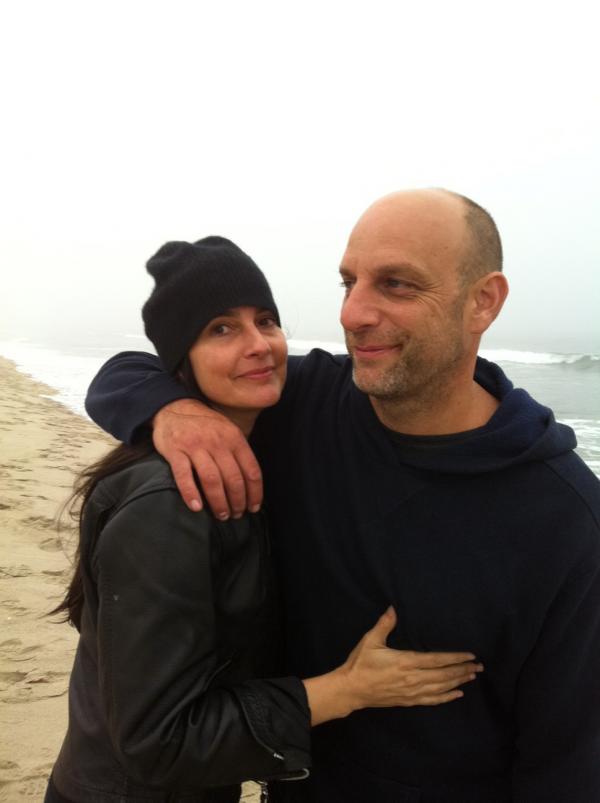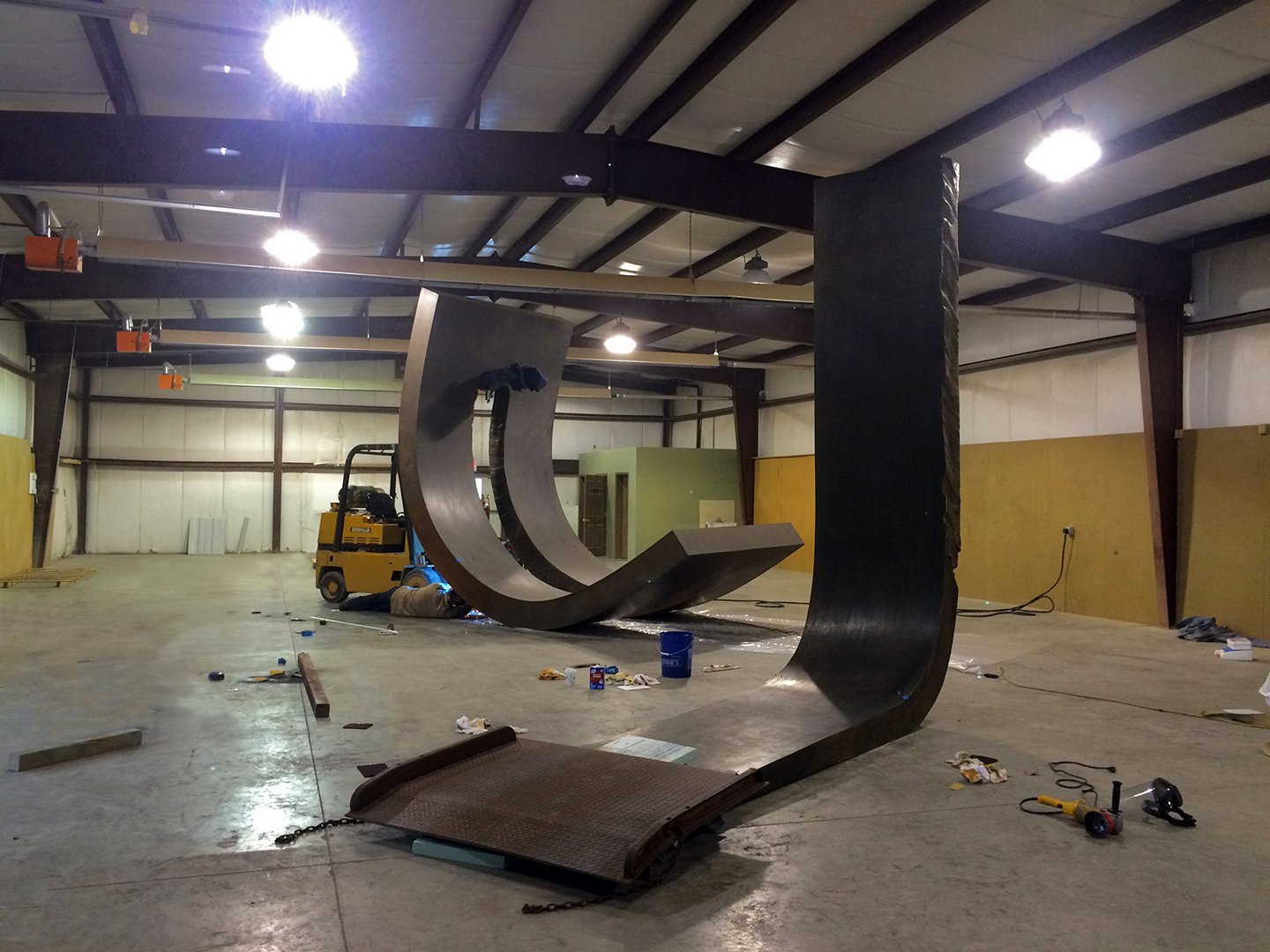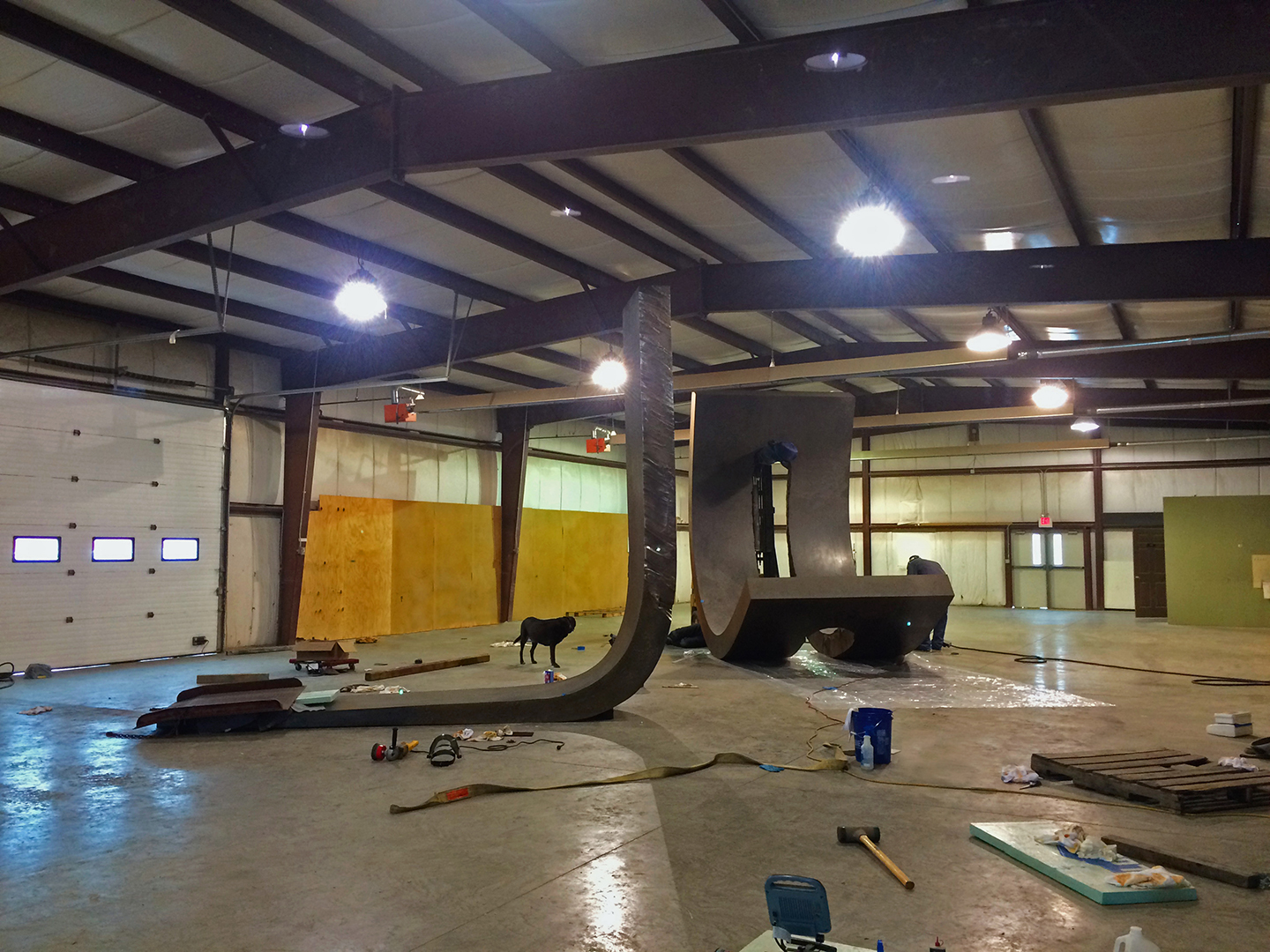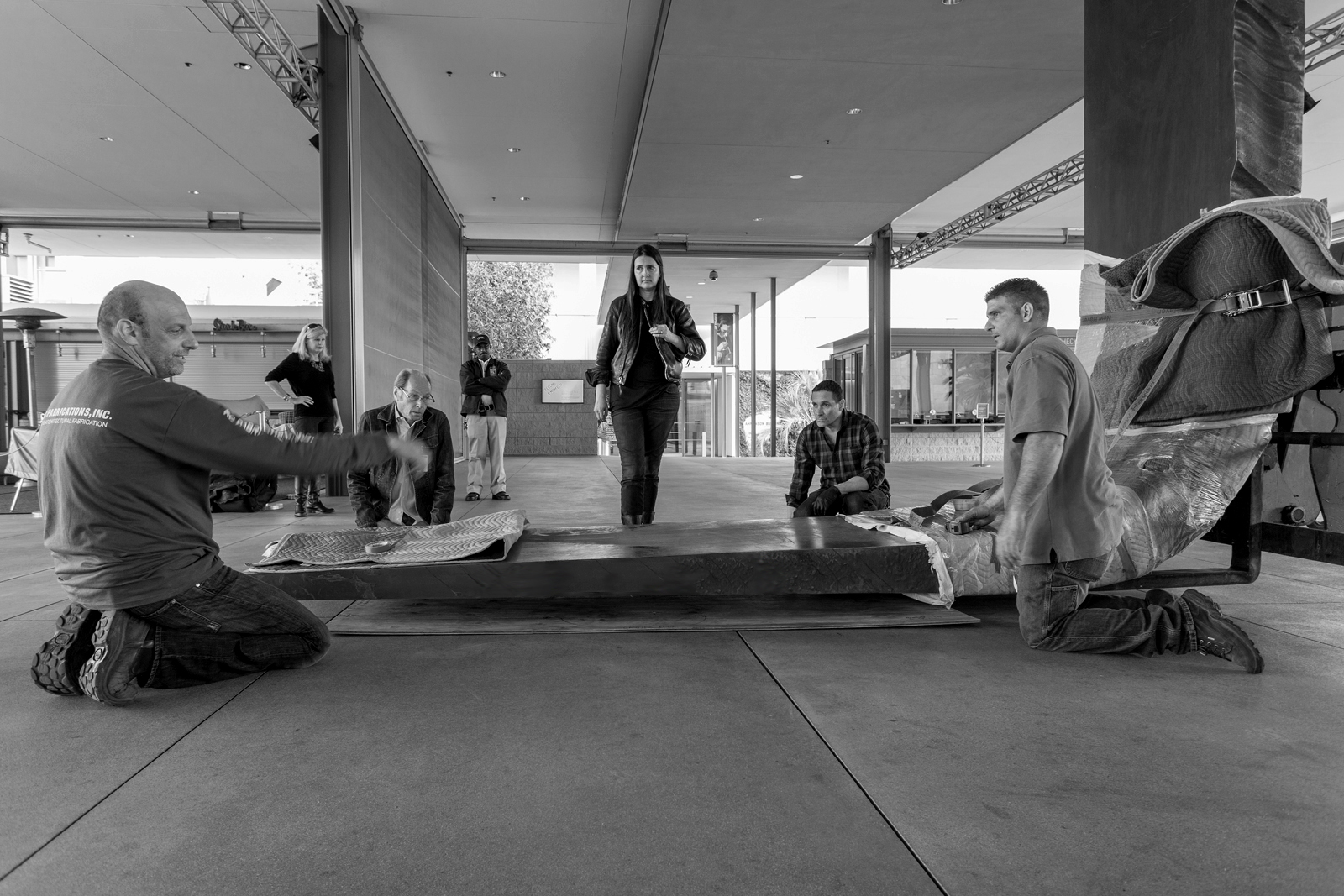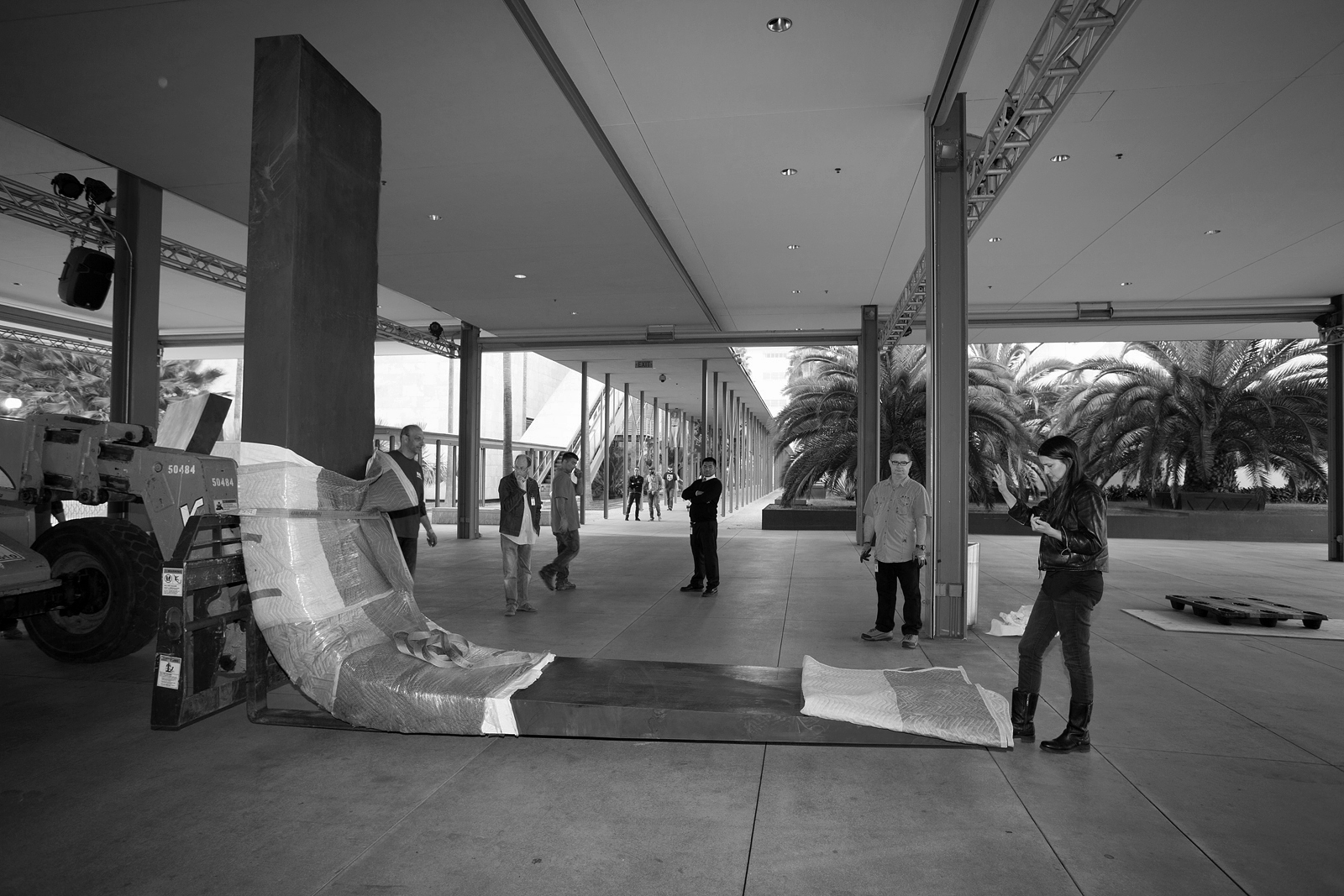Back in December, right after Christine Corday and Christopher Powers finished installing KNOUN and UNE as part of the exhibition Christine Corday: Protoist Series, Selected Forms, I sat down with the respective artist and fabricator (terms that, as you'll read below, may be interchangeable) to learn more about how they work and make. I went into our chat knowing a little about Christine (reading as much I could from exhibition materials that were at the ready), and not knowing much at all about Chris's role in the process. The over-two-hour conversation that took place brought to light the symbiotic relationship between artists and fabricators.
Christine credited Chris with helping her realize her ideas, which are sourced from a fantastical mixture both science and art. And Chris was equally grateful to Christine for providing him with a challenging project—turning molten metal alloy into elegant, abstract forms—that tested the limits of his craft.
I mentioned my meeting to Gloria Sutton, assistant professor of contemporary art and new media at Northeastern University, when she was in town as part of a talk she moderated with artist Renée Green. At the talk, Gloria used the phrase "conversation as form" to describe the importance of dialogue as another medium in art production. I returned to this idea when thinking about the conversation I had with Christine and Chris, namely regarding how our casual chat served to articulate something that I felt was not as apparent in the narratives I've read about Christine's work: the equal importance of artist and fabricator.
I went back to Christine and Chris, and the exchange is what you'll read below. Motivated by the answers they were drawing up for me, they eventually began having their own dialogue. I found this to be so indicative of the way I imagine Christine and Christopher to work. It's very iterative and collaborative.
Christine Corday's Introduction
My special date nights were those free Fridays at MoMA—an intimate set of hours that I would be alone in the connective company of crowds. I looked forward to that night at the museum: standing in its line; absorbing the exhibitions; taking in those long, sustained moments with specific works; and spending hours at their library, book after book, at the community table. I ended each these evenings the same way, crossing 53rd and spending my carefully saved $2 on a hot dog at the street vendor, then sitting directly across from the Folk Art Museum. I’d look at its magnificent poured-metal alloy facade and stare at every detail. I appreciated the visionary design work of Billie Tsien and Tod Williams, but was focused on whom I could not readily research: the people who physically turned an idea into reality, those who conceived and realized its material process.
The enduring results of genius can be found at junctures of a shared idea. Great vision is articulated through many: it is a collective and not individual self. As I sat on 53rd, I’d tell myself, “I will find who made this, and I want work with them. One day I will work with them.” For two years, this was my Friday night.
Then came the day I interviewed four different New York fabrication shops to partner in making UNE. I went to the very best, including a new upstart founded by two men who had left directorships of a major fabrication entity to start something smaller and more focused on artists. One of its founders, Christopher Powers, spoke with me on an approach for UNE. At the close of our meeting, he happened to mention his approach to the panels of the Folk Art Museum.
I lost my breath.
All I could hear was this dull ringing bell in my head—I told him about my years of buying $2 hot dogs across the street from that building. I signed the contract in 2006, we began UNE in 2007, all of it culminating in 2008 at its encounter under the High Line.
Christopher and I began dating in 2009 and got married during working together on the National September 11 Memorial in 2010.
Linda Theung: How does each other's work inform your work? In other words, what have you learned from each other that you've employed in your own practice?
Christine Corday: That every metal—no matter how solid to the senses or formidable or immoveable—is wet clay. A certain fearlessness. His fearlessness and directness combines with a risk-taking native in my own practice. I’ve learned from Chris a material fearlessness. I’ve learned this same fearlessness in seeing as well.
Christopher Powers: Christine has so many qualities that I admire—intelligence, optimism, creativeness, and more drive than anyone I’ve ever met. She thinks big and wants to do great things and keeps moving forward with a bulldog determination and the perfect amount of grace. In my eyes she’s already reached greatness, and I’ve watched how she does it with a respect for the process and a willingness to let the work speak for itself. I use this same attitude in my business, work hard, be part of great projects, and try to treat people the right way along the way.
LT: Did your work change after working together?
CC: Although every work learns from the former, the Protoist series, with their massive cuts, haven’t changed per se but rather experience a tremendous proliferation in its unique problem solving. I would say the work, including series outside the Protoist, have incredible reinforcement, a true confidence in working together with Chris—a most powerful dynamic.
LT: Tell me a little about how you see the importance of working across disciplines, in your case, with an artist and a fabricator?
CC: Both of our disciplines share and revel in problem solving and a work approach. Also after working and living together for almost eight years, we get a sense of each others' approach; Chris sees my ideas, I understand Chris's methodologies. We can have suggestions for each other, but we each don't wear all the hats. Good partnerships blend as well as trust its distinctions. Some aspects of the work we hold together, others each in our own hands. There's something pure to the space given as well as the space shared. Chris has been honing his problem solving for almost 30 years directly with materials, so I have tremendous respect for this and space to this, as his creative realms are vast and powerfully instantaneous. He may feel similar about my idea space and its nature. There's a certain mixture to the air that is needed for a work to become and to breathe—it's an art within the art.
CP: For Christine and I they are one and the same, I’ve always felt the discipline and creativity needed to fabricate the art should be treated as an art itself. We both have opinions and suggestion about both, the art itself and how the fabrication affects it. Thats what makes the process exciting for us.
Editor's note: Questions from Christine to Chris.
Christine Corday: Explain the moment you made your first weld?
Christopher Powers: I was at Chanute Air Force Base in Illinois [now decommissioned], the tech school I was sent to learn welding. Growing up I figured I'd be in graphic design or something creative, but I joined the Air Force first to be able to travel and save for college. When a recruiter told me they had a spot as a welder, my first reaction was, "I guess so." I was in class, and we were being taught basic welding skills with a TIG welder. I really didn’t think much of it until that first weld; it was pitch black behind the helmet, and I thought, "No way am I going to see what I’m trying to accomplish." I pushed on the foot peddle to create an arc, then I watched the arc form in the dark in front of me. It slowly created a puddle, and I added a rod to the puddle to create the weld bead. Surprised by what I did, I pulled up my helmet and saw this perfectly bright silver weld with a bit of purple in it, and I was hooked. From then on I realized a weld is as much a piece of art as anything else I’ve ever made and treated it with respect, always excited to try and lay down a perfect weld, whether I’m fabricating a piece of art or putting together a rack for our shop.
CC: You've been around artists and architects for almost 30 years and worked on significant projects such as the 9/11 memorial and the Folk Art Museum with artists Michael Heizer, Louise Bourgeois, and Frank Stella, among others.
CP: The 9/11 Memorial is the most significant piece of work I'll ever have had the opportunity to work on because of the history and circumstances. Being part of the Memorial team is something you never forget: meeting victims' families and seeing firsthand what this work has meant to so many people. There isn’t much that needs to be said as to why it made such an impact on peoples' lives.
CC: What makes a work of art lasting or significant?
CP: To me, it needs to either represent a moment in time that's unforgettable or something that pushes boundaries, forces a response, and creates a debate about greatness. Art and architecture is so abstract—I think too many times we wait for something or someone familiar to come along and are quick to judge it significant or great, whether it has pushed the limits of what's possible or not. Greatness can come from anyone at anytime and will stand the test of time.
CC: You have the reputation of achieving the impossible and trusted profoundly by the artists who work with you. How does this begin?
This is easy: longevity really is the key, proving over and over again that you look for the biggest challenges and can produce in demanding situations. The biggest lesson I’ve learned in reaching that point is surrounding yourself with amazing fabricators, the best subcontractors, and never admitting that something is impossible. Admitting someone is smarter than you is the easiest way to solving any problem, I’ve always found it easy to ask for advice and call the smartest people when challenged, and that's the best way to educate yourself. With artists I’ve worked with, I think they know I'll do everything in my power to meet whatever need they may have, be it a deadline issue, design issue, or engineering issue. Every project really does become a personal challenge, and I treat every project, large or small, with the same respect.
CC: How does your mind work? How do you approach a piece?
CP: I always approach each piece the same: I look at it and break it down into the simplest form. l see the piece finished, then work backwards and deconstruct it in my mind; it always breaks down the work into something much more simple and creates a blueprint to base the entire fabrication off of, making it easier to get started. It always depends on the piece I may be working on, but I tend to work on instincts and feel quite a bit. Once all the parts are in front of me, it's just a matter of starting and feeling it come together. When I hit a difficult section or am unsure of the next step, I prefer to stand and just look at the work quietly for a few minutes, which always will bring an answer. Once the work starts to come together, and you finally see the artist's vision appear, the rest of the project is just about the details, making everything perfect and meeting a schedule.
CC: What is it like to work with me?
Everyone always says, "Uh oh, you don’t want to work with your spouse all the time, it's to much time together." Working with Christine is the opposite, being married to someone that loves the exact same thing you love, wants to work on that same thing as much as you and cares the same about it, I’m the luckiest guy in the world. Working on Christine's work specifically, I'd say I have the best job in the world. Normally I don’t have the artist next to me through the entire process, and that has opened my eyes to a whole new world as to what an artist is thinking and what they want to say but might not otherwise. We have an undeniable connection to her work when we make it and have two different perspectives, the artist and the fabricator. When we are making a piece we hit every emotion you can think of, its an intense process that involves a lot of debates, technique questions, and most importantly, a lot of laughing. My job is to create what she envisions, our most memorable moments are probably when I’m in the early stages of fabrication, and she may not see what I see, and I don’t see what she sees. We methodically give each other's opinions and reasoning for that particular problem and, in the end, we come to an agreement. It's just a great feeling knowing I get to wake up and go to work with Christine every day and learn from each other.
Editor's note: Questions from Chris to Christine.
Christopher Powers: When did you decide to give up former careers (science and design) and become a painter?
Christine Corday: I began as a child and adolescent with the arts at the piano. Painting and drawing was symbiotic with the piano. I don't think I ever left being an artist—maybe it's more about the exact moment I gave myself the permission.
As for science, which I explored before my years as a designer, my mentor at NASA/SETI gave me great advice. I was in my early 20s, tortured in deciding whether to follow a PhD in astrophysics or continue in art. Although my mentor advocated astrophysics, he saw how distraughtI was about the decision and said to simply choose one and set about its mastery, and whatever else needs to be will enter along the way of devotion to that one thing. And so when I devoted wholly to art, science continues to enter into the studio along the way, true to his advice. It seems life doesnt leave one for the other; life looks for commitment perhaps.
After eight years in commercial and structural design firms, the final decision to wholly become a fine artist occurred. There's no weekly paycheck as an artist—as with any entrepreneur, it's a pact with the unknown, you find what you are made of, what you are willing to sacrifice. The answer to that, by the way, is unwaveringly everything. The exact moment I became a painter was with an artist friend of mine in late 1990s—we packed a car full of materials (paints, paper towels, oil, turpentine) and headed to Astonia, Washington, and set up at the beach, painting all day, painted into the night. We painted in absolute darkness with several works in no light, a new moon. It was veracious, it began exactly then, some early morning on the coast of Astonia, punctuated later with some hot-pepper jelly on toast and coffee.
CP: When did you first think you no longer wanted to paint, but turn to sculpture, and why?
CC: It was 2005, in my Brooklyn studio, I had Beethoven on my iPod. It was rather odd this juxtaposition, this small listening storage device. I thought what it would be like to be in 1824 Vienna in the theater awaiting his ninth. Its premiere, 10 years since he had stepped on a stage. An evening so eruptive—five ovations—authorities were called to calm the crowd. And this evening, this first moment to hear his ninth, wasn't recorded by anything other than the bodies of those who experienced it.
This brought a notion of bodies as recorders and how memory dissolves as the recording device (the body) deteriorates. Paint in my studio had nearly become a first form in the manner of how I made the paint, mulled it, looking to intensify its mark. I handmade its tools of application, and the canvas was raw no longer with a ground. The canvas could dissolve completely to me if only to hold a certain duration of the mark. This intensification of the mark, something akin to a body of memory or a surface to record intensification. It occurred to me to replace my paint with heat. Previously my mark-making transferring little energy from room-temperature paint to a room-temperature canvas. What if I used a plasma torch, at a temperature of say 7,000–10,000F, to transfer the stroke to metal? UNE is this singular mark bent to then enter its beginning and end, not folded like a door frame, but curved to greater suspend this mark's entry and exit for human perception.
UNE was my first "sculpture."
CP: Why metal and steel and not other materials?
CC: I was looking for a material that could have a dialogue with human touch both at the surface as well as have some lasting duration. Human touch oxidizes the metal surface. Metal has a certain duration and durability as a medium for this mark. When I saw metal heated for the first time and could almost see through it, I was hooked. And it reopened cosmology for me, how I connect with the material in terms of interrupting or suspending its billions of years reformations from core of other suns to the ores of this planet and isotopes within our body. Its vernacular as medium became tremendously expanded. All metals come from space. This space. Our space. It's not without its politics and treatment of our planet and people.
Metals are elements. As in nearly three-quarters of our periodic table. Each is so interesting to me, and I intend to use as many as I can. There is something pure to iron, copper, manganese, nickel, etc. that, regardless of its material state from solid to liquid to gas to plasma to condensate, it remains recognizably iron, copper, manganese, nickel, etc. They are changeless in different states. This changeless aspect to this material lends, expands, informs its medium in my work.
Metals provide the perfect medium for the Protoist works, as that tremendous heat from different elemental plasmas used to melt and cut these works reveal a moment between material states of these metals—i.e, iron cooled in a moment suspended between its solid and liquid state. This in-and-out of the solid state interests me. I have great connection to the material, materiality as with the minimalists However a material's truth, or being "it is what it is," has larger context once it leaves the bias of how we encounter it in solid state.
Metals require mechanics far larger than the human hand, yet must still pass through it. With the Protoist works still dictated by touch, its material duration or duration of memory at the surface.
CP: How does your mind work? how do you approach a piece?
CC: I never, not a day, lose cognition of the material connection we share and call the universe, this outward material evidence of an expansion of space as time, the orientation of being on a planet, cooled and coalesced from this and other suns, forces great and small, a perspective that is formed from an arena not concerned with up or down but rather finding truer perspective without it. A position that can only be measured relative to another: what is not absolute. This resides with the work. I'm interested in a pace with the work that materially understands the all too-easily said yet rarely felt durations stated as millions, billions of years. This pace, this materiality in every state informs the work. How the universe became human and shares in the intense love, hate, fragility, brutality. This 500-million-year magnificent, evolving, and yet limited palette of senses we have as tools.
In my studio, little pieces of paper clutter my tables—Louis Kahn "hammering on the door of the sun demanding an instrument of expression," the image of Niemeyer standing with his plans for Brasilia, pictures of the condensation cones formed around objects moving at transonic speeds. I don't approach the work with all this in the hand, but they are well-worn, well-handled subjects in the whole of the body, whole of the mind. They are presentm but not a conscious tool.
CP: What is it like to work with me?
CC: Amazing. A perfect day for us is the open shop floor, some tools, a pot of coffee and our dog. I partner with a complete genius. We make the same great sacrifices without hesitation. We work very hard and somehow is our play—a very serious and dedicated one—it's a shared dedication. It's how we live, how we think, how we relax. The harder we work, the greater its satisfaction. We are exactly alike in its saturation, which makes our domestic life and our professional life near indistinguishable. It wouldn't work any other way. At any hour, at every hour, our work is in focus. Chris is a tremendously generous man. He brings that generosity into every project and every artist and architect he works with, and I love that. His great knowledge is a safety for the work, a tremendous command and epic capability. He's a hero to his projects and all artists who work with him would say the same. That he learned to weld changed my life and the life of so many. It's exactly the word amazing, and more.



